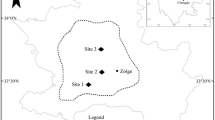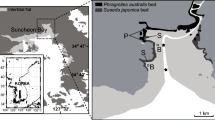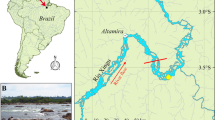Abstract
Hydroperiod is considered an important aspect in shaping community structure and ecosystem patterns in temporary wetlands. However, most studies have focused on the community structure, demonstrating that biotic diversity increases with hydroperiod. Theory suggests that ecosystem patterns like trophic interactions and food web structure will also respond to hydroperiod in the same way. However, there are limited studies exploring ecosystem structure and patterns to changing hydroperiod in temporary wetlands. Maloti-Drakensberg Mountain region of southern Africa has a series of rock pools (shorter hydroperiod) and tarns (longer hydroperiod) that allowed us to explore the effect of hydroperiod on aquatic biodiversity and trophic interactions using stable isotope techniques. We hypothesised that tarns will have higher biotic diversity and complex food web structure as compared to rock pools, which we expected to exhibit low biotic diversity and simple food web structure. Our results were in agreement with our hypothesis, where tarns were characterised by longer food chain length, higher trophic level diversity, greater trophic divergence and even species distribution in the isotopic space. Thus, demonstrating a well-developed and complex food web structure. In contrary, rock pools were characterised by shorter food chain length, small trophic diversity with trophic redundancies and species clustering. Thus, representing a simple and a poorly developed food web structure. Further, macroinvertebrate biotic diversity was significantly higher in longer hydroperiods, also longer hydroperiod exhibited less dramatic changes in the physicochemistry characteristics, representing a more stable environment than shorter hydroperiods. This study demonstrates that hydroperiod not only affects aquatic biological diversity but ecosystem structure, as well.





Similar content being viewed by others
References
Anderson MJ, Willis TJ (2003) Canonical analysis of principal coordinates: an ecologically meaningful approach for constrained ordination. Ecology 84:511–525
Batzer DP (2013) The seemingly intractable ecological responses of invertebrates in North American wetlands: a review. Wetlands 33:1–15
Brendock L, Jocque M, Hulsman A, Vanschoewinkel B (2010) Pools on the rocks: freshwater rock pools as model systems in ecological and evolutionary research. Limnetica 29:25–40
Cabana G, Rasmussen JB (1996) Comparison of aquatic food chains using nitrogen isotopes. Proc Natl Acad Sci USA 93:10844–10847
Carbutt C (2019) The Drakensberg Mountain Centre: a necessary revision of southern Africa’s high-elevation centre of plant endemism. S Afr J Bot 124:508–529
Chatanga P, Kotze DC, Janks M, Sieben EJJ (2019) Classification, description and environmental factors of montane wetland vegetation of the Maloti-Drakensberg region and the surrounding areas. S Afr J Bot 125:221–233
Clark VR, Barker NP, Mucina L (2011) The great escarpment of Southern Africa: a new frontier for biodiversity exploration. Biodivers Conserv 20:2543–2561
Clark VR, Barker NR, Mucina L (2012) Taking the scenic route the southern Great Escarpment (South Africa) as part of the Cape to Cairo floristic highway. Plant Ecol Divers 4:313–328
Clarke KR, Gorley RN (2006) Plymouth Routines in Multivariate Ecological Research. PRIMER v6: use manual/Tutorial. PRIMER-E: Plymouth
Coronel JS, Declerck S, Brendonck L (2007) High-altitude peatland temporary pools in Bolivia house a high cladoceran diversity. Wetlands 27:1166–1174
Daemen EAMJ (1986) Comparison of methods for the determination of chlorophyll in estuarine sediments. Neth J Sea Res 20:21–28
Dalu T, Wasserman RJ, Froneman PW, Weyl OLF (2017a) Trophic isotopic carbon variation increases with pond’s hydroperiod: evidence from an Austral ephemeral ecosystem. Sci Rep 7:7572
Dalu T, Wasserman RJ, Vink TJF, Weyl OLF (2017b) Sex and species-specific isotopic niche specialisation increases with trophic complexity: evidence from an ephemeral pond ecosystem. Sci Rep 7:43229
Day JA, de Moor IJ (2002a) Guides to the Freshwater Invertebrates of Southern Africa. Volume 5: Non-Arthropods. Water Research Commission, Pretoria
Day JA, de Moor IJ (2002b) Guides to the Freshwater Invertebrates of Southern Africa. Volume 6: Arachnida and Mollusca. Water Research Commission, Pretoria
Day JA, de Moor IJ, Stewart BA, Louw A (2001a) Guides to the Freshwater Invertebrates of Southern Africa. Volume 3: Crustacea II. Water Research Commission, Pretoria
Day JA, de Stewart B, Moor IJ, Louw A (2001b) Guides to the freshwater invertebrates of southern Africa. Volume 4: Crustacea III. Water Research Commission, Pretoria
de Moor IJ, Day JA, de Moor FC (2003a) Guides to the freshwater invertebrates of Southern Africa. Volume 7: Insecta I. Water Research Commission Report no. TT 207/03. Pretoria, South Africa
de Moor IJ, Day JA, de Moor FC (2003b) Guides to the Freshwater Invertebrates of Southern Africa. Volume 8: Insecta II. Water Research Commission Report no. TT 214/03. Pretoria, South Africa
de Necker L, Manfrin A, Ikenaka Y, Ishizuka M, Brendonck L, van Vuren JHJ, Sures B, Wepener V, Smit NJ (2020) Using stable δ13C and δ15N isotopes to assess foodweb structures in an African subtropical temporary pool. Afr Zool 55:79–92
DeColibus DT, Rober AR, Sampson AM, Shurzinske AC, Walls JT, Turetsky MR, Wyatt KH (2017) Legacy effects of drought alters the aquatic food web of a northern boreal peatland. Freshw Biol 62:1377–1388
Dunnink JA, Curtis CJ, Beukes JP, van Zyl PG, Swartz J (2016) The sensitivity of Afromontane tarns in the Maloti-Drakensberg region of South Africa and Lesotho to acidic deposition. Afr J Aquat Sci 41:413–426
Eggermont H, Verschuren D, Audenaert L, Lens L, Russell J, Klaassen G, Heiri O (2010) Limnological and ecological sensitivity of Rwenzori mountain lakes to climate warming. Hydrobiologia 648:123–142
Gleason JE, Rooney RC (2018) Pond permanence is a key determinant of aquatic macroinvertebrate community structure in wetlands. Freshw Biol 63:264–277
Hamer ML, Martens K (1998) The large Branchiopoda (Crustacea) from temporary habitats of the Drakensberg region, South Africa. Hydrobiologia 384:151–165
Hanford JK, Webb CE, Hochuli DF (2020) Management of urban wetlands for conservation can reduce aquatic biodiversity and increase mosquito risk. J Appl Ecol 57:794–805
Hill JM, Jones RW, Hill MP, Weyl OLF (2015) Comparisons of isotopic niche widths of some invasive and indigenous fauna in a South African river. Freshw Biol 60:893–902
Holm-Hansen O, Riemann B (1978) Chlorophyll-a determination: improvements in methodology. Oikos 30:438–447
Hoorn C, Perrigo A, Antonelli A (2018) Mountains, climate and biodiversity. Wiley, Oxford
Jackson MC, Britton JR (2014) Divergence in the trophic niche of sympatric freshwater invaders. Biol Invasions 16:1095–1103
Jackson AL, Inger R, Parnell AC, Bearhop S (2011) Comparing isotopic niche widths among and within communities: SIBER—stable isotope Bayesian ellipses in R. J Anim Ecol 80:595–602
Jackson MC, Donohue I, Jackson AL, Britton JR, Harper DM, Grey J (2012) Population-level metrics of trophic structure based on stable isotopes and their application to invasion ecology. PLoS One 7:1–12. https://doi.org/10.1371/journal.pone.0031757
Jackson MC, Fourie HE, Dalu T, Woodford DJ, Wasserman RJ, Zengeya TA, Ellender BR, Kimberg PK, Jordaan MS, Chimimba CT, Weyl OLF (2020) Food web properties vary with climate and land use in South African streams. Funct Ecol. https://doi.org/10.1111/1365-2435.13601
Jocque M, Vanschoewinkel B, Brendock L (2010) Freshwater rock pools: a review of habitat characteristics, faunal diversity and conservation value. Freshw Biol 55:1587–1602
Kneitel JM, Samiylenko N, Rosas-Saenz L, Nerida A (2017) California vernal pool endemic responses to hydroperiod, plant thatch, and nutrients. Hydrobiologia 801:129–140
Körner C, Spehn EM (eds) (2002) Mountain biodiversity: a global assessment. Parthenon Publication Group, Boca Raton
Kovalenko KE (2019) Interactions among anthropogenic effects on aquatic food webs. Hydrobiologia 841:1–11
Layman CA, Arrington DA, Montana CG, Post DM (2007) Can stable isotope ratios provide for community-wide measures of trophic structure? Ecology 88:42–48
Ledger ME, Brown LE, Edwards FK, Milner AM, Woodward G (2013) Drought alters the structure and functioning of complex food webs. Nat Clim Change 3:223–227
Lorenzen CJ (1967) Determination of chlorophyll and phaeophytin: spectrophotometric equations. Limnol Oceanogr 12:343–346
Magnusson AK, Williams DD (2006) The roles of natural temporal and spatial variation versus biotic influences in shaping the physicochemical environment of intermittent ponds: a case study. Archiv für Hydrobiologie 165:537–556
Martens K, De Moor F (1995) The fate of the Rhino Ridge pool at Thomas Baines Nature Reserve: a cautionary tale for conservationists. S Afr J Sci 91:385–387
Mlambo MC, Bird MS, Reed C, Day JA (2011) Diversity patterns of temporary wetland macroinvertebrate assemblages in the south-western Cape, South Africa. Afr J Aquat Sci 36:299–308
Motitsoe SN, Coetzee JA, Hill JM, Hill MP (2020) Biological control of Salvinia molesta (D.S. Mitchell) drives aquatic ecosystem recovery. Diversity 12:204
Nel J, Colvin C, Le Maitre D, Smith J, Haines I (2013) Defining South Africa’s Water Source Areas. WWF-SA, Cape Town
Nhiwatiwa T, Brendonck L, Dalu T (2017) Understanding factors structuring zooplankton and macroinvertebrate assemblages in ephemeral pans. Limnologica 64:11–19
O’Neill BJ, Thorp JH (2014) Untangling food-web structure in an ephemeral ecosystem. Freshw Biol 59:1462–1473
Olsson K, Stenroth P, Nyström P, Granéli W (2009) Invasions and niche width: does niche width of an introduced crayfish differ from a native crayfish? Freshw Biol 54:1731–1740
Peel RA, Hill JM, Taylor GC, Weyl OLF (2019) Food web structure and trophic dynamics of a fish community in an ephemeral floodplain lake. Front Environ Sci 7:192
Polis GA, Anderson WB, Holt RD (1997) Toward an integration of landscape and food web ecology: the dynamics of spatially subsidized food webs. Annu Rev Ecol Syst 28:289–316
Post DM (2002) The long and short of food-chain length. Trends Ecol Evol 17:269–277
Post DM, Pace ML, Hairston NG Jr (2002) Ecosystem size determines food-chain length in lakes. Nature 405:1047–1049
R Core Team (2018) R: A language and environment for statistical computing. R Foundation for Statistical Computing, Vienna, Austria. https://www.R-project.org/
Roussouw N, Bird MS, Perissinotto R (2018) Microalgal biomass and composition of surface waterbodies in a semi-arid region earmarked for shale gas exploration (Eastern Cape Karoo, South Africa). Limnologica 72:44–56
SANParks (2013) Golden Gate Highlands National Park: Park Management Plan 2013–2023
Schalk CM, Montana CG, Winemiller KO, Fitzgerald LA (2017) Trophic plasticity, environmental gradients and food-web structure of tropical pond communities. Freshw Biol 62:519–529
Schriever TA, Williams DD (2013) Influence of pond hydroperiod, size, and community richness on food-chain length. Freshw Sci 32:964–975
Shumilova O, Zak D, Datry T, von Schiller D, Corti R, Foulquier A et al (2019) Simulating rewetting events in intermittent rivers and ephemeral streams: a global analysis of leached nutrients and organic matter. Glob Change Biol 25:1591–1611
Sieben EJJ, Kotze DC, Morris CD (2010) Floristic composition of wetlands of the South African section of the Maloti-Drakensberg Transfrontier Park. Bothalia 40:117–134
Stenert C, Maltchik L (2007) Influence of area, altitude and hydroperiod on macroinvertebrate communities in southern Brazil wetlands. Mar Freshw Res 58:993–1001
Taylor SJ, Ferguson JWH, Engelbrecht FA, Clark VR, Van Rensburg S, Barker N (2016) The Drakensberg Escarpment as the Great Supplier of Water to South Africa. In: Greenwood GB, Shroder JF (eds) Mountain ice and water: investigations of the hydrologic cycle in alpine environments. Elsevier, Oxford, pp 1–46
Taylor GC, Weyl OLF, Hill JM, Peel RA, Hay CJ (2017) Comparing the fish assemblages and food-web structures of large floodplain rivers. Freshw Biol 62:1891–1907
Taylor PJ, Kearney T, Dalton DL, Chakona G, Kelly CMR, Barker NP (2020) Biomes, geology and past climate drive speciation of laminate-toothed rats on South African mountains (Murinae: Otomys). Zool J Linnean Soc. 10.1093
Travers SL, Jackman TR, Bauer AM (2014) A molecular phylogeny of Afromontane dwarf geckos (Lygodactylus) reveals a single radiation and increased species diversity in a South African montane center of endemism. Mol Phylogenet Evol 80:31–42
Urban MC (2004) Disturbance heterogeneity determines freshwater metacommunity structure. Ecology 85:2971–2978
Van Damme K, Eggermont H (2011) The Afromontane Cladocera (Crustacea: Branchiopoda) of the Rwenzori (Uganda–D.R. Congo): taxonomy, ecology and biogeography. Hydrobiologia 676:57–100
Van Damme K, Bekker E, Kotov AA (2013) Endemism in the Cladocera (Crustacea: Branchiopoda) of Southern Africa. J Limnol 72:440–463
Vander Zanden MJ, Rasmussen JB (1999) Primary consumer δ13C and δ15N and the trophic position of aquatic consumers. Ecology 80(4):1395–1404
Vander Zanden MJ, Cabana G, Rasmussen JB (1997) Comparing trophic position of freshwater fish calculated using stable nitrogen isotope ratios (d15N) and literature dietary data. Can J Fish Aquat Sci 1158:1142–1158
Vander Zanden MJ, Casselman JM, Rasmussen JB (1999) Stable isotope evidence from the food web consequences of species invasion in lakes. Nature 401(6752):464–467
Vander Zanden MJ, Chandra S, Allen BC, Reuter JE, Goldman CR (2003) Historical food web structure and restoration of native aquatic communities in the Lake Tahoe (California-Nevada) Basin. Ecosystems 6:274–288
Venables WN, Ripley BD (2002) Random and mixed effects. In: Venables W, Ripley BD (eds) Modern applied statistics with S. Statistics and Computing, New York, pp 271–300
Waterkeyn A, Vanschoenwinkel B, Grillas P, Brendonck L (2010) Effect of salinity on seasonal community patterns of Mediterranean temporary wetland crustaceans: a mesocosm study. Limnol Oceanogr 55:1712–1722
Williams DD (2006) The biology of temporary waters. Oxford Biology, Oxford, p 268
Williams AJ, Trexler JC (2006) A preliminary analysis of the correlation of food-web characteristics with hydrology and nutrient gradients in the southern Everglades. Hydrobiologia 569:493–504
Yu J, Liu Z, He H, Zhen W, Guan B, Chen F, Li K, Zhong P, Mello FT, Jeppesen E (2016) Submerged macrophytes facilitates dominance of omnivorous fish in a subtropical shallow lake: implications from lake restoration. Hydrobiologia 775:97–107
Acknowledgements
This research was funded through the Rhodes University Research Council Fund. Further funding for this work was provided by the National Research Foundation of South Africa and the Department of Higher Education and Training: The New Generation of Academics Programme. Any opinion, finding, conclusion or recommendation expressed in this material is that of the authors and the NRF does not accept any liability in this regard. We are grateful to the South African National Parks (SANParks): Golden Gate Highlands National Park Eastern Free State especially Hendrik Sithole and Dr Charlene Bissett for facilitating our research permit (No: MLAMC1466) and staff at the Golden Gate Highlands National Park in particular Mr Dhiraj Nariandas and section rangers Mr Mokoena and Tshabalala for providing access and logistical support to undertake this research within the park. Daniel Rogers is also thanked for his assistance in the field.
Author information
Authors and Affiliations
Corresponding author
Ethics declarations
Conflict of interest
The authors have no conflicts of interest to declare that are relevant to the content of this article.
Additional information
Publisher's Note
Springer Nature remains neutral with regard to jurisdictional claims in published maps and institutional affiliations.
Rights and permissions
About this article
Cite this article
Mdidimba, N.D., Mlambo, M.C. & Motitsoe, S.N. Trophic interactions and food web structure of aquatic macroinvertebrate communities in afromontane wetlands: the influence of hydroperiod. Aquat Sci 83, 36 (2021). https://doi.org/10.1007/s00027-021-00792-w
Received:
Accepted:
Published:
DOI: https://doi.org/10.1007/s00027-021-00792-w




